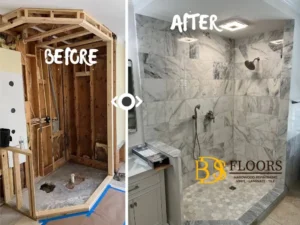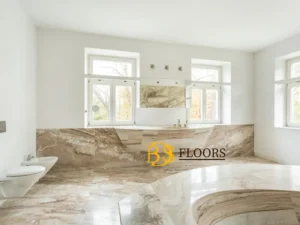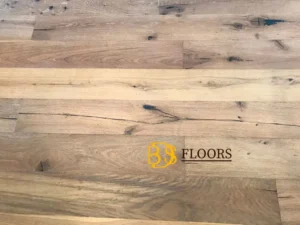Discover the top 5 hardwood flooring options that you should know when considering new floors. Don’t get overwhelmed by the different choices available, instead, learn which type of wood flooring will not only look great but also withstand wear and tear for a long time, all while fitting within your budget.
Despite being one of the oldest flooring materials, hardwood remains a popular choice among homeowners due to its timeless appeal and ability to enhance any decor style. In addition to its aesthetic value, hardwood flooring is a durable, sustainable, and renewable option that comes in various colors and grain patterns to suit different design preferences and lifestyles.
The top five hardwood species for residential flooring include oak, walnut, hickory, maple, and cherry, each with unique properties. However, before choosing a species, it’s crucial to understand the differences between solid and engineered hardwood flooring and consider finishing options as well. This article provides all the information you need to make an informed decision and select the best hardwood flooring for your home.
Solid vs. Engineered Hardwood Flooring
When it comes to hardwood flooring, there are two main options to choose from: solid and engineered. Solid hardwood floors consist of boards made from a single piece of wood, while engineered hardwood flooring has a multi-layer base topped with a layer of real hardwood. While solid hardwood is generally more expensive, prefinished solid red oak flooring costs around $5 per sq. ft., while engineered red oak flooring costs $1 to $2 less (depending on the thickness of the hardwood layer).
When deciding between solid and engineered hardwood, it’s important to consider both the advantages and disadvantages of each option. While solid hardwood offers a timeless look and can be refinished multiple times, it may not be suitable for every application and is more prone to shrinking and expanding with changes in humidity. On the other hand, engineered hardwood is more versatile and can be used in areas with higher moisture levels, but it may not be as durable and cannot be refinished as many times as solid hardwood.
Solid hardwood flooring…
Solid hardwood flooring has the potential to last for decades because it can be refinished multiple times. This type of flooring is designed for installation over a wood subfloor, where each board is individually nailed to the subfloor. However, solid hardwood flooring is not suitable for installation on a concrete substrate because it requires nailing. Additionally, it’s not recommended for below-grade installations, such as in a basement, due to the increased humidity and residual moisture which can cause warping.
Exposure to high humidity can also cause “cupping” in solid hardwood flooring. Since each board is nailed on the edges, when the wood swells, the boards push on each other, creating a cupped depression along the center of the board. Furthermore, gaps between the seams can occur if the wood contracts, which may happen if the moisture level in the wood was higher during installation. To prevent gaps, it’s recommended to allow the boards to acclimate to the room climate for at least two weeks before installation.
Engineered Hardwood Flooring…
Engineered hardwood flooring is composed of multiple thin layers, including compressed wood, resin, and polymers, topped with a layer of real hardwood. Unlike solid hardwood flooring, engineered flooring planks are fitted and snapped together via grooves on the sides of the planks, making it a “floating floor” that is not physically attached to the floor beneath. This allows for installation over various types of existing flooring, such as wood, tile, or linoleum, as long as the existing floor is level and even concrete.
Engineered hardwood flooring can often be installed in basements due to its ability to withstand higher humidity, although moisture resistance may vary depending on the brand. Some manufacturers claim that their product can be refinished once or twice if they use a thicker layer of surface hardwood. However, most engineered hardwood flooring cannot be refinished.
One advantage of engineered flooring is that it will not cup or cause gaps between seams. The floor is installed with an expansion space around its perimeter, allowing it to accommodate any swelling or contraction while remaining flat and level. Engineered hardwood flooring also comes prefinished, so once it’s installed, nothing more is required.
Hardwood Finishing 411
Previously, hardwood flooring was installed without a finish coat, and a professional would then apply stain and a durable topcoat for protection. However, now prefinished hardwood flooring is available with stain and topcoat already applied.
Unfinished hardwood flooring:
- Provides a smooth surface with no board-height discrepancy as it is installed and then sanded.
- Allows for customized colors by installing unfinished flooring and having the stain mixed at a paint store.
- Is more time-consuming to install because it is finished in phases – installation, sanding, staining, finishing – which can take three or more days.
- Involves mess and potentially toxic fumes during sanding and finishing, requiring proper ventilation.
- Has lower material costs, typically about $1 per sq. ft. less than prefinished flooring. For example, unfinished Red Oak flooring costs around $4 per sq. ft. while prefinished Red Oak costs around $5 per sq. ft.
The installation of unfinished hardwood is costlier due to the additional labor required for staining and finishing. Hiring a professional to install and finish the flooring may result in higher costs compared to prefinished flooring, depending on labor costs in your area. While a professional installer may offer a warranty for defects in workmanship during the finishing process, if you install the flooring yourself, you won’t have any recourse if the finish wears off prematurely due to normal usage.
Prefinished hardwood flooring…
Comes in a limited range of colors. Customization is not an option. Has higher material costs initially but lower installation costs compared to unfinished hardwood flooring. With prefinished flooring, staining and finishing are already done, so the professional installation process is usually quicker and less expensive. In the end, a prefinished hardwood floor may be less expensive than an unfinished one. Does not require sanding, so there is no exposure to dust or toxic fumes during the installation process. Comes with manufacturer warranties that often cover defects in stain and finish coat.
Hardwood Species
After gaining knowledge about flooring, you can start selecting the hardwood species that match your preferences in color tones, wood grain patterns, and durability. To measure wood hardness, the Janka Hardness Scale is the industry standard, named after Gabriel Janka, an Austrian researcher who developed the scale in 1906. The rating number represents the wood’s hardness, with higher numbers indicating a more durable floor.
Oak is a popular hardwood species that offers two distinct types, both highly desirable for flooring.
Red oak is the most popular hardwood flooring option available today, with a Janka rating of 1290, making it suitable for most flooring needs. Its warm tones range from creamy pink and golden red to rusty brown. It features elegant swirled grain patterns throughout and can vary slightly in color and grain pattern from one board to the next. Red oak complements various decor styles, including classic, rustic, contemporary, and country.
White oak is a good option for high traffic areas due to its hardness, rated at 1360 on the Janka scale. It is chosen for its fine grain patterns and cool hues, featuring gray undertones and no hint of red. Its grain and color only slightly vary, resulting in a smooth and elegant floor that suits many design styles.
Cherry is a hardwood with warm brown tones and a smooth grain pattern. However, it is not as hard as some other options, ranking 950 on the Janka scale, making it better suited for low-traffic areas like bedrooms or formal dining rooms. Over time, cherry may darken slightly, especially with exposure to sunlight. Installing wide planks up to 8 inches can help highlight its beautiful grain pattern.
Walnut is a popular choice for its deep chocolate tones and large, straight grain patterns that give it a sophisticated look. With a Janka rating of 1010, it is suitable for medium-to-light traffic but may show wear in high-traffic areas after a few years. Walnut floors have slight color variations from board to board, resulting in a smooth, consistent appearance.
Hickory, on the other hand, has a Janka rating of 1820, making it very durable and ideal for high-traffic zones. It features mocha tones ranging from creamy beige with a hint of red to warm brown with dark brown streaks. With large knots and varying colors from board to board, hickory is well-suited for rustic and country styles.
Maple is another highly durable choice with a Janka rating of 1450, suitable for most rooms. It has a light color that ranges from light cream and beige to tan, often with a slight reddish tint. Maple has a fine grain pattern with occasional dark streaks and specks that add visual interest. This hardwood complements many styles, including contemporary, transitional, and eclectic.







